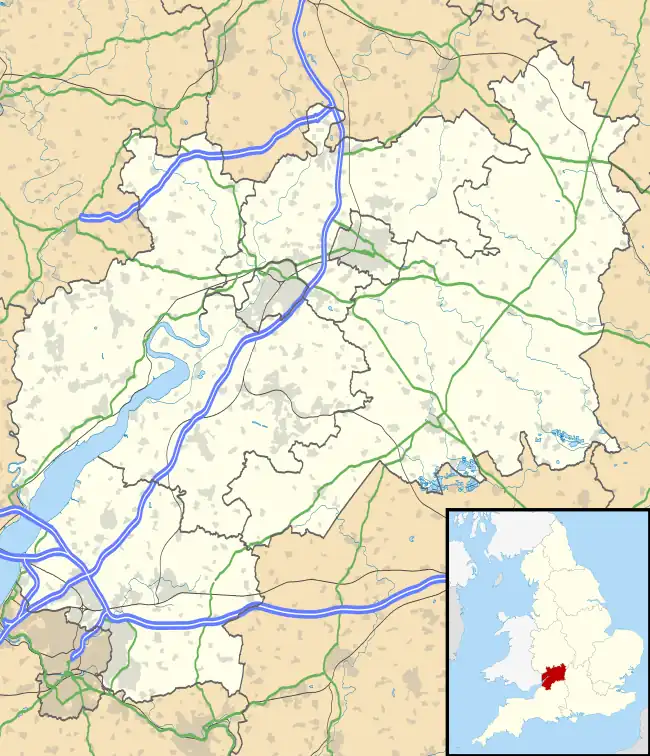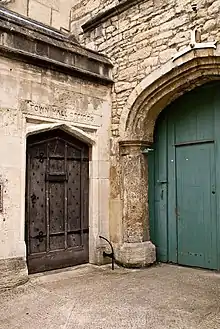| Old Town Hall | |
|---|---|
.jpg.webp) Old Town Hall, Stroud | |
| Location | The Shambles, Stroud |
| Coordinates | 51°44′43″N 2°12′57″W / 51.7454°N 2.2157°W |
| Built | 1596 |
| Architectural style(s) | Gothic style |
Listed Building – Grade II* | |
| Official name | Town Hall |
| Designated | 25 June 1974 |
| Reference no. | 1267688 |
 Shown in Gloucestershire | |
The Old Town Hall is a municipal building in The Shambles, Stroud, Gloucestershire, England. The town hall, which was the headquarters of Stroud Urban District Council, is a Grade II* listed building.[1]
History

Following the granting of a charter to hold markets in 1594, the lord of the manor at Over Lypiatt, John Throckmorton, decided to commission a market hall; the new building was designed in the neoclassical style and completed in 1596.[1] The original design involved a symmetrical main frontage with four bays facing onto the Market Place; it was arcaded on the ground floor to allow markets to be held; an assembly room with a large oriel window was established on the first floor.[2][3]
A village lock-up was created in the basement of the building in the 17th century[4] and a school was established on the first floor of the building in the early 18th century:[5] the physicist, John Canton, attended the school at that time.[6] Part of the building was converted into a tailor's spinning house in the late 18th century.[2]
The building was first used for municipal purposes as a meeting place for the local vestry in the early 19th century.[2] It was extended to a design by Francis Niblett to accommodate the county court in 1851[7] and, after becoming the offices of the local board of health, it was remodelled in the gothic style with a large gable containing mullion windows erected above the two central bays in 1856.[2] In order to improve the stability of the building, large buttresses, flanking the two central bays, were installed on the front of the building in 1890.[2] After significant population growth, partly associated with the number of dye works in the town, the area became an urban district with the town hall as its headquarters in 1894.[8]
Following an increase in the responsibilities of the council, civic leaders acquired the former offices of the Gloucester Banking Company in the High Street in 1930; the High Street building was converted for municipal use and was subsequently referred to as the "Council Chambers".[2] Although most council officers and their departments moved to the new Council Chambers in the High Street, some departments, including the technical services department, remained in the old building.[9] The old town hall remained in municipal use even after the enlarged Stroud District Council was formed in 1974.[10][11] However, in 1986, the council acquired Ebley Mill, once the largest mills of its type in the south west of England, with a view to converting it for office use for council officers and their departments.[12] Following the preparation of a feasibility study, a programme of improvement works was implemented at the town hall after the council moved out in 1988.[13][14]
Wall hangings created to commemorate the 400th anniversary of the granting of a charter to the town were completed in 1994 and subsequently hung in the building.[15]
See also
References
- 1 2 Historic England. "Town Hall (1267688)". National Heritage List for England. Retrieved 17 April 2021.
- 1 2 3 4 5 6 Baggs, A. P.; Jurica, A. R. J.; Sheils, W. J. (1976). "'Stroud: Growth of the town and outlying settlements', in A History of the County of Gloucester: Volume 11, Bisley and Longtree Hundreds, ed. N M Herbert and R B Pugh". London: British History Online. pp. 104–111. Retrieved 17 April 2021.
- ↑ "Shambles Market Stroud". Gloucestershire.info. Retrieved 17 April 2021.
- ↑ "Stroud Lock-up (Town Hall)". Prison History. Retrieved 17 April 2021.
- ↑ "Key Landmarks - Stroud Town - Old Town Hall". Digital Stroud. Retrieved 17 April 2021.
- ↑ "Stroud Local History Society: Barry Harrison asks - Who was John Canton?". Stroud News and Journal. 13 April 2016. Retrieved 17 April 2021.
- ↑ Graham, Clare (2017). Ordering Law The Architectural and Social History of the English Law Court to 1914. Taylor & Francis. ISBN 978-1351913577.
- ↑ "Stroud UD". Vision of Britain. Retrieved 17 April 2021.
- ↑ "No. 44348". The London Gazette. 22 June 1967. p. 6939.
- ↑ Local Government Act 1972. 1972 c.70. The Stationery Office Ltd. 1997. ISBN 0-10-547072-4.
- ↑ Municipal Journal. Vol. 91. 1983. p. 1414.
- ↑ "Stroud District Council lets out office space at Ebley Mill to generate extra income". Stroud News and Journal. 15 January 2020. Retrieved 17 April 2021.
- ↑ ""Putting the Roof Back on… ": An exhibition celebrating 30 years of the Stroud Preservation Trust" (PDF). Stroud Preservation Trust. 19 November 2012. p. 27. Retrieved 17 April 2021.
- ↑ "Stroud District Council Offices open at Ebley Mill". Stroud Local History Society. Retrieved 17 April 2021.
- ↑ "Exhibitions". Stroud Local History Society. Retrieved 17 April 2021.